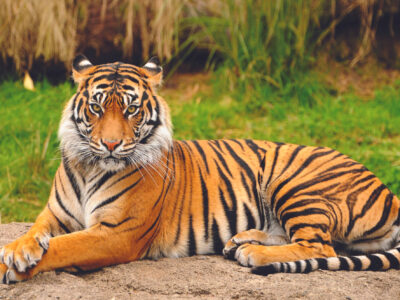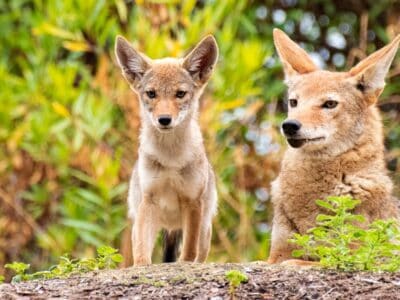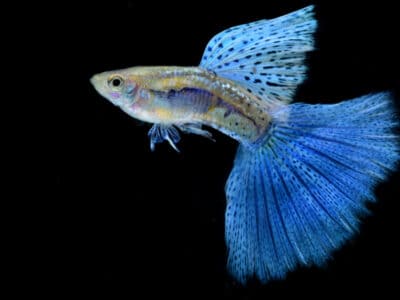Skink Lizard
Some skinks lay eggs in some habitats while giving birth to skinklets in other habitats.
Advertisement
Skink Lizard Scientific Classification
Read our Complete Guide to Classification of Animals.
Skink Lizard Conservation Status
Skink Lizard Facts
- Prey
- Flies, crickets, grasshoppers, beetles, and caterpillars
- Name Of Young
- skinklets
- Group Behavior
- Solitary
- Fun Fact
- Some skinks lay eggs in some habitats while giving birth to skinklets in other habitats.
- Estimated Population Size
- Unknown
- Biggest Threat
- Man
- Most Distinctive Feature
- Lizard-like body with short legs or no legs at all
- Other Name(s)
- Skinks
- Gestation Period
- 30-75 days
- Litter Size
- 10-18
- Habitat
- Varies depending on species
- Predators
- Foxes, raccoons, opossums, skunks, shrews, moles, birds
- Diet
- Carnivore
- Type
- Reptiles
- Location
- Worldwide
Skink Lizard Physical Characteristics
- Color
- Brown
- Grey
- Red
- Green
- Orange
- Skin Type
- Scales
- Top Speed
- 65 mph
- Lifespan
- Varies by species
- Weight
- 1gram – 907 grams (1 ounce – 32 ounces)
- Length
- 7.5 cm - 81cm (3in – 32 in)
- Age of Sexual Maturity
- 3 months - 36 months
- Age of Weaning
- 2 days -12 months
View all of the Skink Lizard images!
The Skink Lizard are the second largest group of lizards in the world.
They live in diverse locations globally. While some skinks lay eggs, others give birth to live babies called skinklets, and at least one species does both. Most of these reptiles live under piles of leaves and logs, where they can quickly burrow in the ground or hide in hollow logs when predators, such as foxes and raccoons, are nearby. Some live in wetlands and streams. Skinks are great at climbing trees, where they often hunt for insects, sleep, and hide from predators. Find some facts and everything you need to know about skinks here.
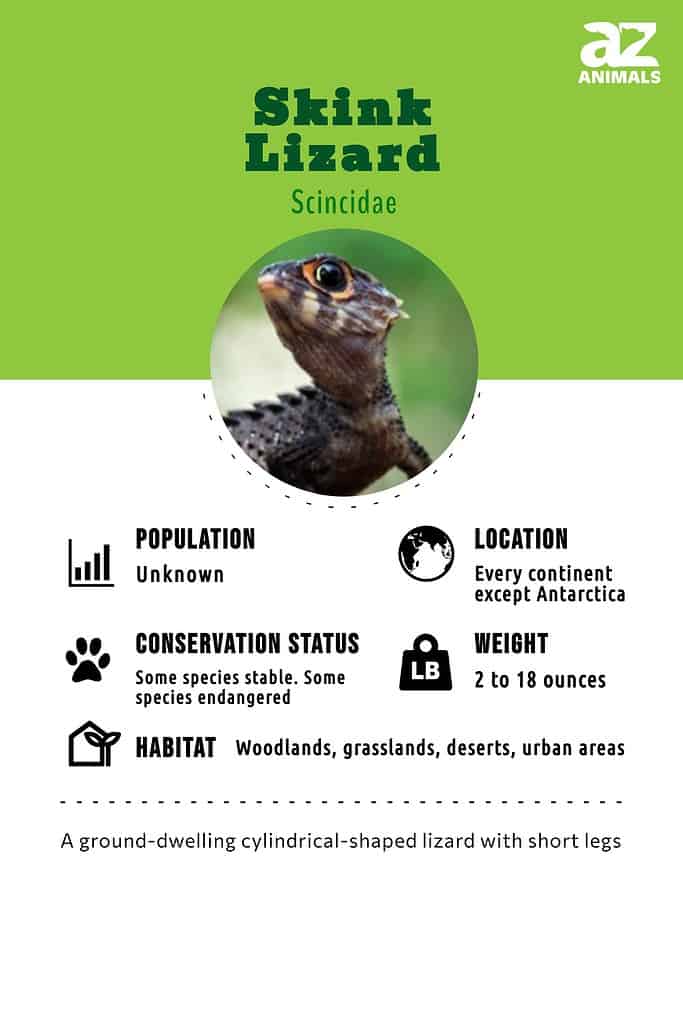
5 Incredible Facts!
- The size of the skink depends on the species. Smaller species are usually 3 inches long, while large species can reach up to 14 inches in length.
- Skinks are often confused with snakes because they have very short necks, small legs, and snake-like body motions.
- The average common garden skink lives for 2–3 years.
- Skinks are diurnal (active during the day).
- While blue-tongued skink lizards are generally thought of as being very docile and curious, they can deliver a powerful and painful bite.
Scientific Name
All skinks are members of the infraorder Scincomorpha and the family Scincidae. There are more than 1,500 species of skinks, which are divided into at least seven subfamilies. These subfamilies include:
- Acontinae – These limbless skinks are generally live-bearing sand swimmers who live in Africa.
- Egerniinae – These skinks are found worldwide and can grow up to 220 millimeters (8.6 inches) long. Unlike most skinks, members of this subfamily often live in groups.
- Eugongylinae – Members of this subfamily often live in New Zealand and Australia.
- Lygosominae – Many members of this family are called supple skinks or writhing skinks. They generally live in Southeast Asia, India, and Africa.
- Mabuyinae – These tropical skinks live in Asia, Africa, and the Americas. Scientists believe that members of this subfamily rafted from Africa to the Americas about 18 million years ago.
- Sphenomorphinae – Members of this subfamily are sometimes called comb-eared skinks because of how the scales align behind this black skink’s ears.
- Scincinae – Some of the most endangered skinks in the world belong to this subfamily, which often lives in the Philippines and other Southeast Asia locations.
Evolution
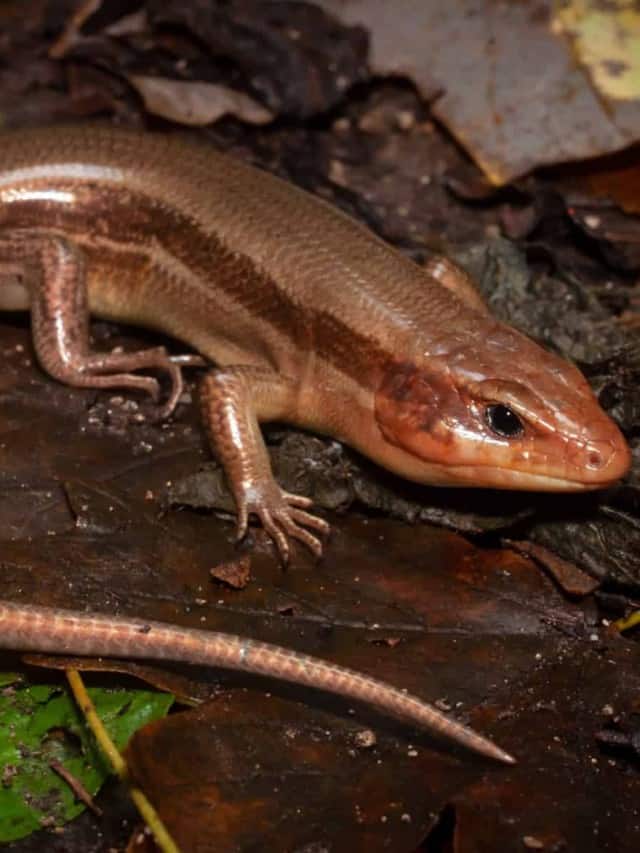
Skinks have evolved over millions of years.
©Mike Wilhelm/Shutterstock.com
The skink lizard is a type of reptile that has been around since the time of the dinosaurs. They can be found in a variety of habitats, from deserts to rainforests, and are well-known for their ability to camouflage with their surroundings. The evolutionary history of skinks dates back millions of years, when they first evolved from other reptiles like iguanas or monitor lizards. Since then, they have adapted and diversified into different species which inhabit many different regions across the globe.
Skinks are believed to have originated in Africa and spread outwards over time via continental drift and other migratory patterns. Over hundreds of thousands of years, skinks have undergone genetic changes that allowed them to survive in various climates and terrains while still maintaining their basic characteristics as a species. From this process arose new variations on the classic skink form – some having longer tails or more vibrant colors than others – all suited for specific environmental conditions within each habitat they occupy today.
Appearance
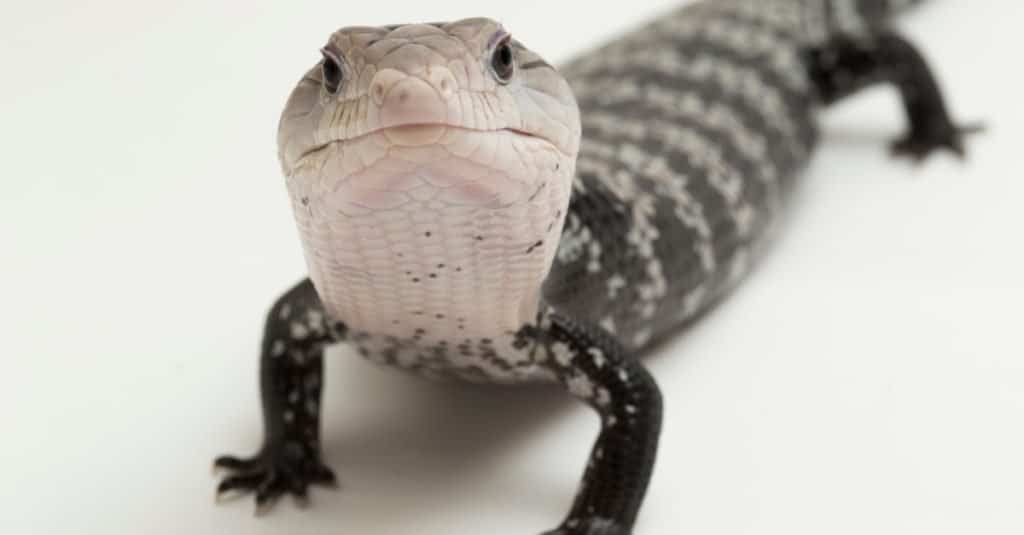
Giant blue-tongued skink lizards have very short legs.
©dwi putra stock/Shutterstock.com
Skinks look like lizards, except that almost all of them have very short legs. Some species of skinks have no limbs at all. Most skinks have no necks.
While it is not always the case, skink lizards usually have a dark background and light longitudinal stripes. One of the most common skinks in Texas is the five-lined skink. This Texas skink is black, brown, or gray with five long lines down its body, white or yellow. This Texas skink which is often called a common garden skink usually grows to be between 5-and-8 inches long. Young members of this Texas skink family have blue tails.
One of the rarest skinks in Florida is the mole skink. The body of this Florida skink is covered with shiny, armor-like scales. This Florida skink seldom grows to be over 5 inches long. Unlike the blue tail on the common garden skink, this skink has a reddish-pink tail. It is the southernmost skink found in the United States.
Behavior
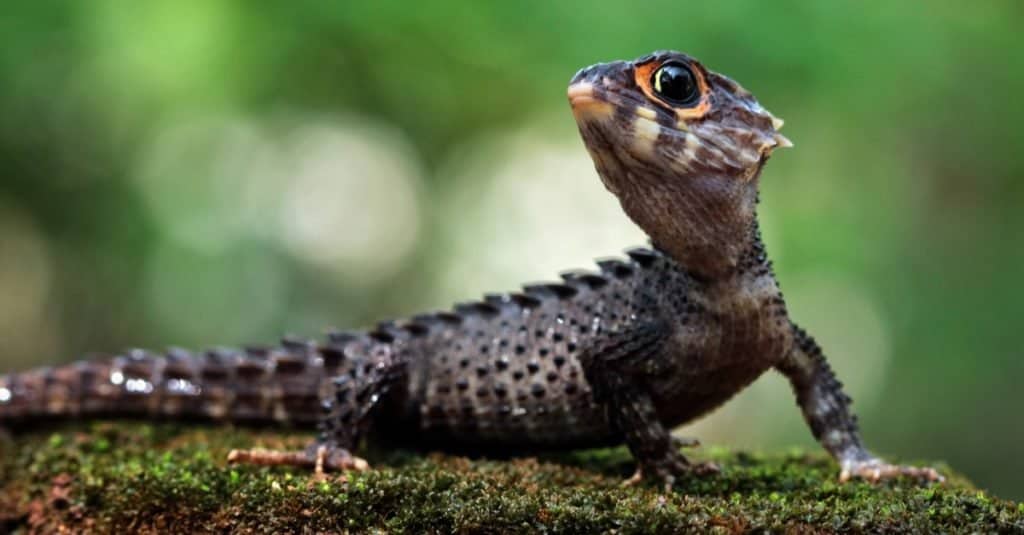
©Kurit afshen/Shutterstock.com
Depending on the species, skinks can exhibit many different behaviors. Most are slow-moving reptiles unless they feel threatened. Then, they can run at speeds up to 65 miles per hour.
Some species of skinks have fascinating behaviors. For example, the blue-tongued skink that lives in Australia, New Guinea, and Tasmania puffs up its body and sticks its baby blue tongue out when it is frightened. While puffing up its body makes it look bigger, no one is sure why it sticks its tongue out.
Many skinks, such as the blue caboose with its bright blue tail, can shed their tails if caught by a predator. This allows them to get away from danger.
While most skink lizards are extremely shy, typically, they are not aggressive and are definitely not dangerous. They would prefer to use their fast speed and their ability to hide under logs or piles of leaves to avoid detection. One of the most aggressive species of skink is the blue-tongue skink. Pygmy blue-tongue skinks, with their very short blue tails, are among the rarest of skinks.
Habitat

Skinks live in many different habitats. Most are like the common ground skink and prefer to live in an area where they can dig a burrow. As the common ground skink, you may see many sitting on a rock sunning themselves because they are cold-blooded reptiles.
Many, like the five-lined and broad-headed skinks, climb trees. They will often sleep there, and it is often a place to get away from their predators.
Skink lizards are found in a variety of habitats, from woodlands and grasslands to deserts and urban areas. They prefer moist environments where they can easily hide beneath the debris, such as leaf litter or logs. Skinks tend to live near water sources like streams or ponds, often spending time basking on rocks in the sun nearby. In some regions, skinks may also be found living in underground burrows or even termite mounds. Generally speaking, skinks prefer warm climates but can survive in cooler temperatures with adequate shelter for protection during cold winters.
Diet
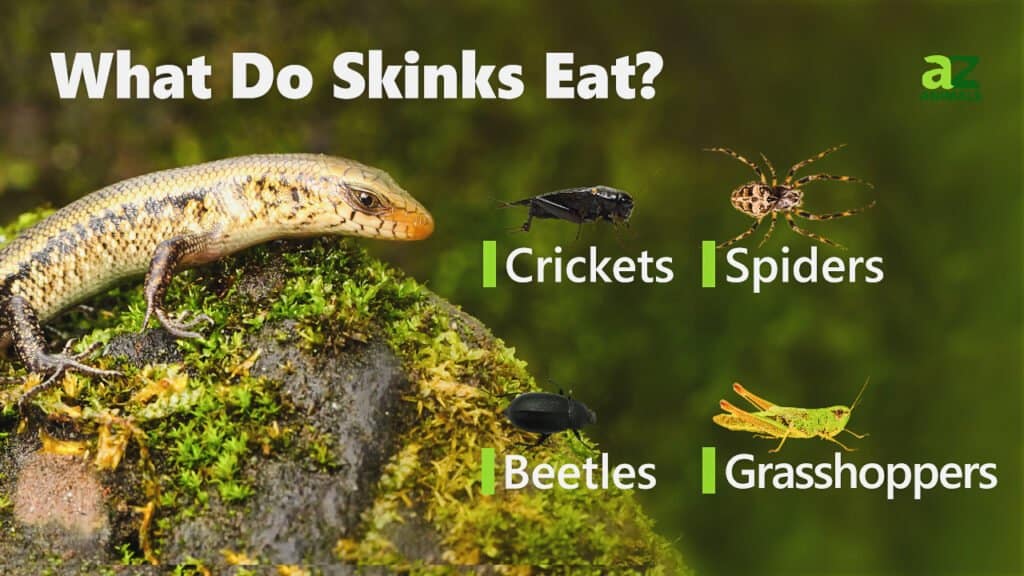
Most skinks eat insects. In fact, many gardeners try to attract common garden skinks to their gardens because they eat crickets, moths, slaters, earthworms, flies, grubs and caterpillars, and grasshoppers. Most skinks do not have a large appetite, so they may only eat one insect every few days. Some skinks will also eat small pieces of fruit.
Blue-tongue skinks like to dine on insects and fruit. Not all skinks, however, share this preference. For example, the giant water skink lives in Southern Australian streams, where it eats tadpoles, tiny frogs, and other small skinks. In Madagascar, skinks even cover crabs with their bodies and break off their limbs for a tasty meal.
Predators and Threats

Five-lined Skink Lizards have to watch out for hawks and other birds of prey.
©James DeBoer/Shutterstock.com
Since skinks live in such diverse habitats, they face several different predators. In the wild, crows, hawks, and other birds of prey often eat skinks. They are also a favorite meal for many small mammals, like raccoons, foxes, possums, cats, and dogs. Other members of the lizard family often eat them.
Loss of habitat is also a significant threat for skink lizards. This is a particular problem in Southern Florida, Puerto Rico, and the Virgin Islands where some species, like the Culebra skink, Mona skink, Puerto Rican skink, greater St. Croix skink, lesser St. Croix skink (St. Croix), greater Virgin Islands skink, Virgin Islands bronze skink, and lesser Virgin Islands skink that is only found in minimal locations.
Reproduction and Life Cycle
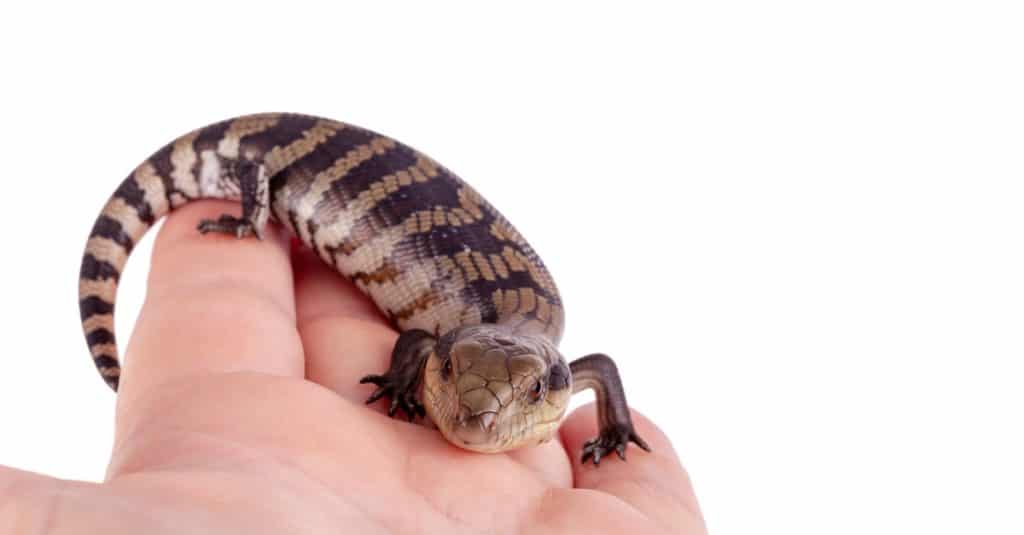
Australian Baby Eastern Skink Lizards are protected by both their mother and father.
©EdwardsMediaOnline/Shutterstock.com
Depending on the species, skinks can either lay eggs or give birth to young. Scientists believe that the same species of skinks can give birth to live hatchlings and lay eggs. They call this process bimodal reproduction, and there are only about three species of lizards in the entire world that can do this. One of them is the Australian three-toed skink. In Northern New South Wales, this skink gives birth to live young, while near Sydney, it lays eggs. Biologists believe that this is an example of reproductive evolution, and eventually, all three-toed skinks will give birth to live offspring.
Skinks that give birth to live offspring carry their eggs in different ways. About 55% of them have eggs that develop inside the mother’s reproductive tract. Others form in the reproductive tract and are fed by a placenta, just like a human baby.
Other species lay eggs in clutches. Most species lay between five-and-30 eggs at one time. Some, like the red-eyed crocodile skink, only lay one egg at a time. The length of time that it takes a skink to hatch also varies widely from 30-to-90 days. It also varies significantly on the level of care given during and after the eggs hatch.
Some males are very active in helping to guard nests, incubate eggs and raise skinklets. Other males are not involved in the process at all, except for being sperm donors. Sexual maturity in male and female skinks is reached at a variety of ages. For example, blue-tongued skinks often reach sexual maturity is reached at about 4.5 months. It is not reached in the red-eyed crocodile skink until the animal is about 3 years old.
Population and Conservation
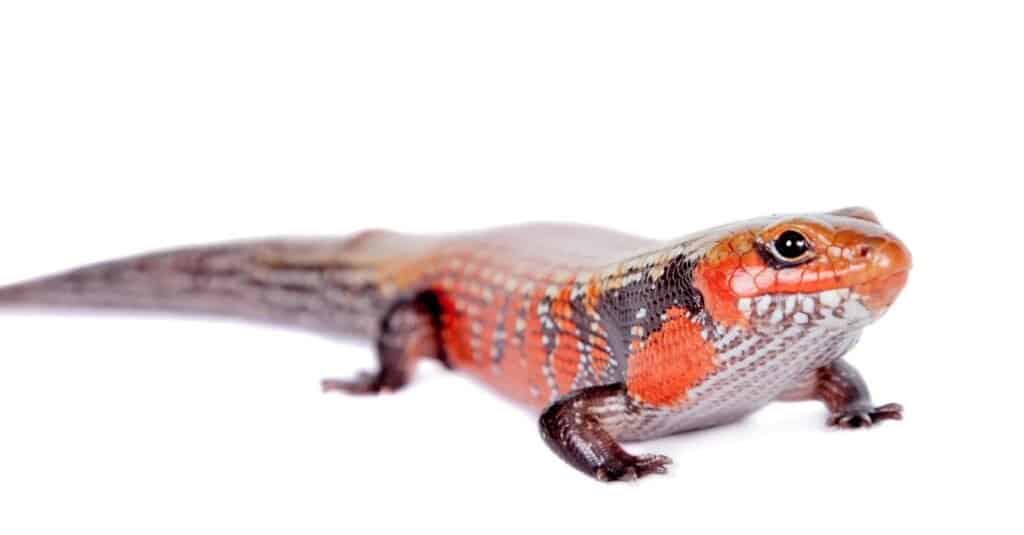
A Fire Skink, Riopa fernandi, has beautiful red markings.
©iStock.com/Farinosa
No one is sure how many skinks there are in the wild. In some areas, like Florida, the number is going down because of habitat loss, while in other regions, skinks are evolving to live closer to humans.
Skink lizards are often considered an important part of local ecosystems, as they feed on insects and help to keep insect populations in check. Unfortunately, many species of skink lizards are facing a conservation crisis due to habitat destruction, climate change, and other human-driven impacts. In some areas, their numbers have been reduced by up to 90%. As a result, conservationists have had to take drastic measures in order to protect the remaining populations. These measures include captive breeding programs, habitat restoration projects, educational campaigns aimed at raising awareness about the plight of skink lizards and other endangered species, and even relocation initiatives that move vulnerable lizard populations out of harm’s way. By taking these steps, we can ensure that future generations will be able to enjoy seeing these amazing animals in the wild for years to come!
Types of Skink Lizards
- Blue-tongued Skink (Tiliqua scincoides)
- Northern Cloudy Skink (Lampropholis guichenoti)
- Crevice Spiny-tailed Skink (Egernia crebonis)
- Emerald Tree Skink (Lipinia noctua)
- Mangrove Skink (Emoia atrocostata)
- Cunningham’s Skinks (Ctenotus cunninghami )
- Yellow-bellied Three-toed Slider (Tribolonotus gracilis )
- Red Eyed Crocodile Skinks( Tribolonotusgracilis )
- Asian Long-Tailed Grass Lizard( Takydromusscrupulous )
Skink Lizard FAQs (Frequently Asked Questions)
Are Skink Lizards Dangerous?
There are no poisonous skinks. If you handle some species, however, they may try to bite you. Others will try to sting you. Generally, they are shy animals who will try to avoid you by hiding under leaves and logs.
Are Skinks Good to Have Around?
Skinks can be an excellent reptile to keep around, especially since they are not poisonous. Many people choose to keep them as a pet. One of the most popular options is the blue-tongued skink. This species that is not poisonous makes a docile pet. This pet is fun to watch as it shows its blue tongue as a defensive mechanism.
Gardeners who know that skinks are not poisonous often love to see skinks among their crops. They are great at eating insects, such as crickets, moths, slaters, earthworms, flies, grubs and caterpillars, and grasshoppers, that eat their crops. Yet, skinks do very little to damage the garden.
What are Skinks Attracted To?
Skinks are attracted to light. They are cold-blooded reptiles, so the light gives off heat, helping to warm their bodies.
What is the Difference Between a Lizard and a Skink?
All skinks are lizards, but not all lizards are skinks. Skinks are the second-largest group of lizards behind geckos. Most skinks have tiny limbs or no limbs at all while other lizards have larger limbs. Most skinks do not have a prominent neck. While lizards tend to run, many skinks move along the ground using a snake-like motion.
What Does a Skink Lizard Look Like?
Since there are over 1,500 species of skinks, they take on a variety of looks. Most have slender bodies that are black, brown, or grey. Look closely at the skink’s body, and you will either see no limbs or very short limbs. Additionally, most have almost no neck and a very underdeveloped head.
What is the Natural Predator of a Skink Lizard?
Birds of many sizes are natural predators of skinks. They often try to hide under leaves, large rocks, or in hollow logs to escape. If caught, skinks can release their tails. This often satisfies the bird, giving skinks time to get away.
Thank you for reading! Have some feedback for us? Contact the AZ Animals editorial team.
Sources
- Potter Park Zoo / Accessed June 17, 2021
- Pets On Mom / Accessed June 17, 2021
- The Conversation / Accessed June 17, 2021
- Beneficials In The Garden / Accessed June 17, 2021
- University of Georgia / Accessed June 17, 2021
- Center For Biological Diversity / Accessed June 17, 2021
- Fish Bio / Accessed June 17, 2021
- Pet MD / Accessed June 17, 2021
- Wikipedia / Accessed June 17, 2021
- Scientific American / Accessed June 17, 2021
- University of Sydney / Accessed June 17, 2021
- Reptile Advisor / Accessed June 17, 2021
- Wiki How / Accessed June 17, 2021









